Source: abava.com
Published: February 21, 2017
At Antonia Bava Landscape Architects we have had the privilege of designing and overseeing ongoing maintenance for the landscaping within the Living Machine at the LEED Platinum SFPUC Administrative Office Building at 525 Golden Gate Ave, San Francisco. This experience has given us a unique insight and understanding of the growing conditions, constraints and challenges of designing a beautiful urban planting within a system that filters grey and black water for reuse.
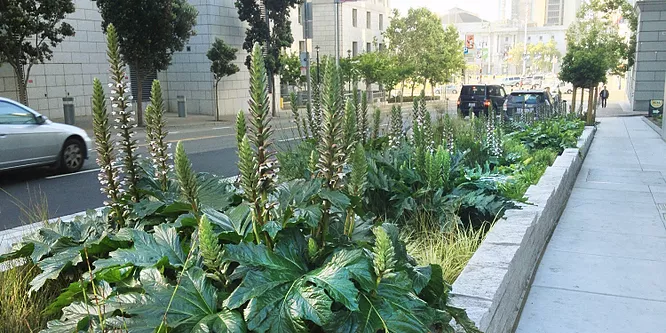
Living Machine is a trademark and patented form of ecological sewage treatment designed to synthesize and accelerates natural wetland conditions through a series of tanks and cells. The process of the living machine begins with the gathering of waste materials in the primary tank. The liquid is then filtered and separated from the solids.
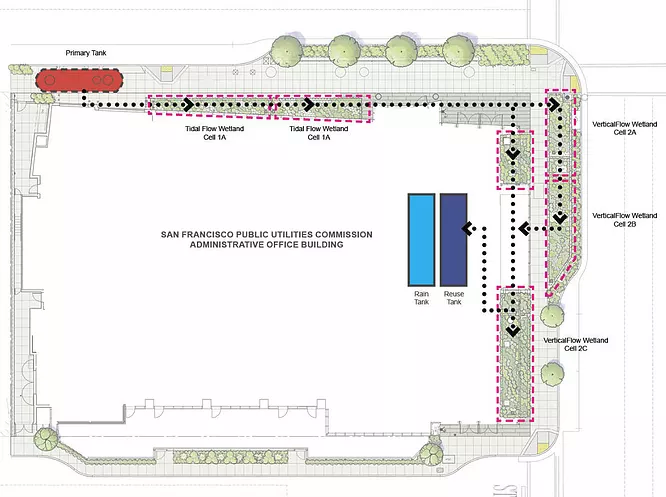
The process of the living machine begins with the gathering of waste materials in the primary tank. The liquid is then filtered and separated from the solids. The filtered water is then pumped into a tank that serves to fill and drain the first series of wetland cells on a consistent basis. This tidal replication provides constant moisture to sustain beneficial microorganisms within the cell substrate to filter out organic material in the liquids. These microorganisms break down toxic compounds within the waste water creating necessary macro and micro nutrients such as (Nitrogen, Potassium, and Phosphorus) for the plants to thrive without additional fertilizers.

After passing through the first tidal flow wetland cells the water is then pumped into the second stage of vertical flow wetland cells. These cells have a system of perforated pipes that pump the water at regular interval and functions similarly to a sub-surface drip irrigation system. Lastly the water is then pumped into a disinfection tank where the liquid is sterilized with ultra violet light for reuse in non-potable use within the SFPUC building.

Designing the plant palette for the Living Machine required a great understanding of the Living Machines functions, water cycles, growing medium etc as well as a vast knowledge of horticulture. The plants selected had to incredibly tough and adapt to drastic changes in moisture levels as well as intense levels of toxins and heavy metals.
Antonia Bava Landscape Architects has spent several years designing, studying and maintaining plant material species appropriate for the Living Machine environment. Below are a few of the species that have been used, with varying degrees of success, in the Living Machine.
Exterior Living Machine

Acanthus mollis
A native to Mediterranean Europe, Acanthus mollis is an incredibly adaptive and resilient plant. It is especially suited for the living machine condition due to its rigorous rhizomatous root structure that insulates the plant during full water submergence and drought conditions. The lush lobed leaves and large flower spikes also provide great ornamental value.

Acorus gramineus
This ornamental grass like plant is native to wetland areas of Asia. Its adaption to wetland conditions makes it an ideal plant for the Living Machine. It slowly spreads and clumps via rhizomatous roots that also have a slight pleasant aroma.

Carex hachijoensis ‘evergold’
This compact variegated sedge is a great addition to the Living Machine due tolerance of wet feet and its beautiful foliage.

Cyrtomium falcatum
This robust attractive fern forms a rounded mound of uniquely shaped dark green leaves. Its preference for fast draining but moist growing conditions makes it an ideal option for the Living Machine.
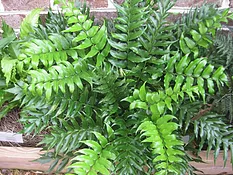
Chondropetalum tectorum
A native to South Africa this grass-like Restio is incredibly adaptable and can thrive in dry and moist conditions making it an ideal plant for the Living Machine. It forms an elegant clump of upright stems that terminate in a cluster of small brown flowers.
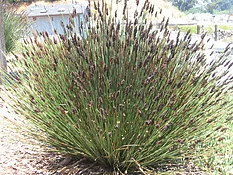
Hackonechloa macra ‘aureola’
This highly ornamental grass-like plant is native to the forests of Japan. Its tolerance of shade and Its preference for moist, yet fast draining soil makes it a great option for the north facing portions of the Living Machine.

Juncus patens
This California native is great option for the Living Machine due to its tolerance of varying moisture conditions and slow rhizomatous spreading habit. It forms a compact clump of upright glaucous needle like leaves that terminate in small inconspicuous brown flowers.
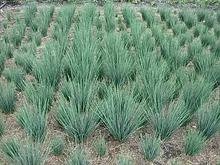
Interior Living Machine

Arum italicum ‘pictum’
This herbaceous plant is native to southern Europe where it grows in sheltered forest with partly moist soil. This plants preference for organically rich soils and shade make in an ideal plant for the interior Living Machine planters.

Cyperus alternifolius
Native to the lake and stream sides of Madagascar this elegant upright plant is perfectly suited for the conditions of the living Machine. With its bold upright nature and lush green foliage this plant serves as a partial scrim between the streetscape and the interior café.

Cyrtomium falcatum
This robust attractive fern forms a rounded mound of uniquely shaped dark green leaves. Its preference for fast draining but moist growing conditions makes it an ideal option for the Living Machine.

Philodendron selloum
This large Brazillian plant has massive lush green, deeply lobed leaves and thrives in low light conditions. It’s an incredibly adaptive and robust plant that makes a great option for the interior Living Machine planter.

Rumora adiatiformis
This highly adaptive fern is well suited for interior plantings and provides a beautiful lush green groundcover in the interior Living Machine areas.

